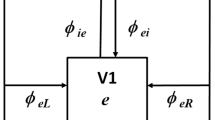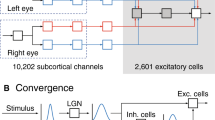Abstract
A general theory previously proposed by the author which describes synaptic stabilization on the basis of three basic assumptions is employed for the understanding of ocular dominance column formation. A reduced mathematical model is constructed based on the thermodynamics in the Ising spin variables representing the afferent synaptic connection distribution. The results of Monte Carlo simulations on the segregation of ipsilateral and contralateral synaptic terminals in the input layer of the primary visual cortex suggest the existence of phase transition phenomena. Three types of ocular dominance column patterns — stripe, blob, and uniform — are visualized according to the values of the correlation strength and the degree of imbalance in activity between the left and right retinas. The theory presented here successfully explains how ocular dominance columns are developed.
Similar content being viewed by others
References
Changeux JP, Danchin A (1976) Selective stabilization of developing synapses as a mechanism for the specification of neuronal networks, Nature 264:705–712
Collingridge GL, Bliss TVP (1987) NMDA receptors — their role in long-term potentiation, Trends Neurosci 10:288–293
Frank E (1987) The influence of neuronal activity on patterns of synaptic connections. Trends Neurosci 10:188–190
Hubel DH, Wiesel TN (1962) Receptive fields, binocular interaction and functional architecture in the cat's visual cortex. J Physiol 160:106–154
Hubel DH, Wiesel TN (1977) Functional architecture of macaque monkey visual cortex. Proc R Soc Lond B198:1–59
Hubel DH, Wiesel TN, LeVay S (1977) Plasticity of ocular dominance columns in monkey striate cortex. Phil Trans R Soc Lond B278:377–409
Hubel DH, Wiesel TN, Stryker MP (1978) Anatomical demonstration of orientation columns in macaque monkey. J Comp Neurol 177:361–380
Kaas JH, Merzenich MM, Killackey HP (1983) The organization of somatosensory cortex following peripheral nerve damage in adult and developing mammals. Ann Rev Neurosci 6:325–356
Kirkpatric S, Gellat CD, Vecchi MP (1983) Optimization by simulated annealing. Science 220:671–680
Knudsen EI, DuLac S, Esterly SD (1987) Computational maps in the brain. Ann Rev Neurosci 10:41–65
LeVay S, Connolly M, Houde J, Van Essen DC (1985) The complete pattern of ocular dominance stripes in the striate cortex and visual field of the macaque monkey. J Neurosci 5:486–501
Linsker R (1986) From basic network principles to neural architecture: Emergence of spatial-opponent cells. Proc Natl Acad Sci USA 83:7508–7512
Livingstone MS, Hubel DH (1984) Anatomy and physiology of a colorsystem in the primate visual cortex. J Neurosci 4:309–356
Metropolis N, Rosenbluth AW, Rosenbluth MN, Teller AH, Teller E (1953) Equation of state calculations by fast computing machines. J Chem Phys 21:1087–1092
Miller KD, Keller JB, Stryker MP (1989) Ocular dominance column development: analysis and simulation. Science 245:605–615
Rakic P (1977) Prenatal development of the visual system in Rhesus monkey. Phil Trans R Soc Lond B278:245–260
Swindale NV (1980) A model for the formation of ocular dominance stripes. Proc R Soc Lond B208:243–264
Tanaka S (1988) Theory of self-organization of cortical maps. In: The proceeding of SICE '88, ESS2–5:1069–1072
Tanaka S (1989) Theory of self-organization of cortical maps. In: Touretzky DS (eds) Advances in neural information processing system, Vol 1. Morgan Kaufmann, San Mateo Calif, pp 451–458
Tanaka S (1990a) Theory of self-organization of cortical maps: mathematical framework. Neural Networks: (to be published)
Tanaka S (1990b) Experience-dependent self-organization of biological neural networks. NEC Res Dev 98:1–14
Von der Malsburg C (1979) Development of ocularity domains and growth behavior of axon terminals. Biol Cybern 32:49–62
Wu FY (1982) The Potts model. Rev Mod Phys 54:235–268
Author information
Authors and Affiliations
Rights and permissions
About this article
Cite this article
Tanaka, S. Theory of ocular dominance column formation. Biol. Cybern. 64, 263–272 (1991). https://doi.org/10.1007/BF00199589
Received:
Accepted:
Issue Date:
DOI: https://doi.org/10.1007/BF00199589




